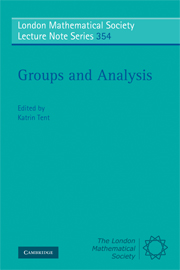Book contents
- Frontmatter
- Contents
- Preface
- List of speakers and talks
- 1 Harmonic analysis on compact symmetric spaces
- 2 Weyl, eigenfunction expansions, symmetric spaces
- 3 Weyl's work on singular Sturm–Liouville operators
- 4 From Weyl quantization to modern algebraic index theory
- 5 Sharp spectral inequalities for the Heisenberg Laplacian
- 6 Equidistribution for quadratic differentials
- 7 Weyl's law in the theory of automorphic forms
- 8 Weyl's Lemma, one of many
- 9 Analysis on foliated spaces and arithmetic geometry
- 10 Reciprocity algebras and branching
- 11 Character formulae from Hermann Weyl to the present
- 12 The Classification of affine buildings
- 13 Emmy Noether and Hermann Weyl
9 - Analysis on foliated spaces and arithmetic geometry
Published online by Cambridge University Press: 12 May 2010
- Frontmatter
- Contents
- Preface
- List of speakers and talks
- 1 Harmonic analysis on compact symmetric spaces
- 2 Weyl, eigenfunction expansions, symmetric spaces
- 3 Weyl's work on singular Sturm–Liouville operators
- 4 From Weyl quantization to modern algebraic index theory
- 5 Sharp spectral inequalities for the Heisenberg Laplacian
- 6 Equidistribution for quadratic differentials
- 7 Weyl's law in the theory of automorphic forms
- 8 Weyl's Lemma, one of many
- 9 Analysis on foliated spaces and arithmetic geometry
- 10 Reciprocity algebras and branching
- 11 Character formulae from Hermann Weyl to the present
- 12 The Classification of affine buildings
- 13 Emmy Noether and Hermann Weyl
Summary
Introduction
For the arithmetic study of varieties over finite fields powerful cohomological methods are available which in particular shed much light on the nature of the corresponding zeta functions. For algebraic schemes over spec ℤ and in particular for the Riemann zeta function no cohomology theory has yet been developed that could serve similar purposes. For a long time it had even been a mystery how the formalism of such a theory could look like. This was clarified in [D1]. However until now the conjectured cohomology has not been constructed.
There is a simple class of dynamical systems on foliated manifolds whose reduced leafwise cohomology has several of the expected structural properties of the desired cohomology for algebraic schemes. In this analogy, the case where the foliation has a dense leaf corresponds to the case where the algebraic scheme is flat over spec ℤ e.g. to spec ℤ itself. In this situation the foliation cohomology which in general is infinite dimensional is not of a topological but instead of a very analytic nature. This can also be seen from its description in terms of global differential forms which are harmonic along the leaves. An optimistic guess would be that for arithmetic schemes χ there exist foliated dynamical systems X whose reduced leafwise cohomology gives the desired cohomology of χ. If χ is an elliptic curve over a finite field this is indeed the case with X a generalized solenoid, not a manifold, [D3].
We illustrate this philosophy by comparing the “explicit formulas” in analytic number theory to a transversal index theorem.
- Type
- Chapter
- Information
- Groups and AnalysisThe Legacy of Hermann Weyl, pp. 174 - 190Publisher: Cambridge University PressPrint publication year: 2008
- 8
- Cited by



